
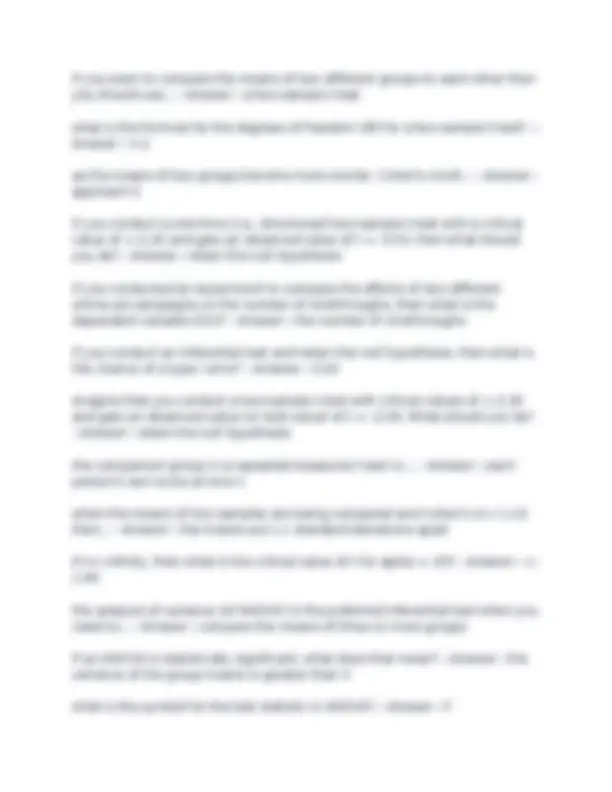
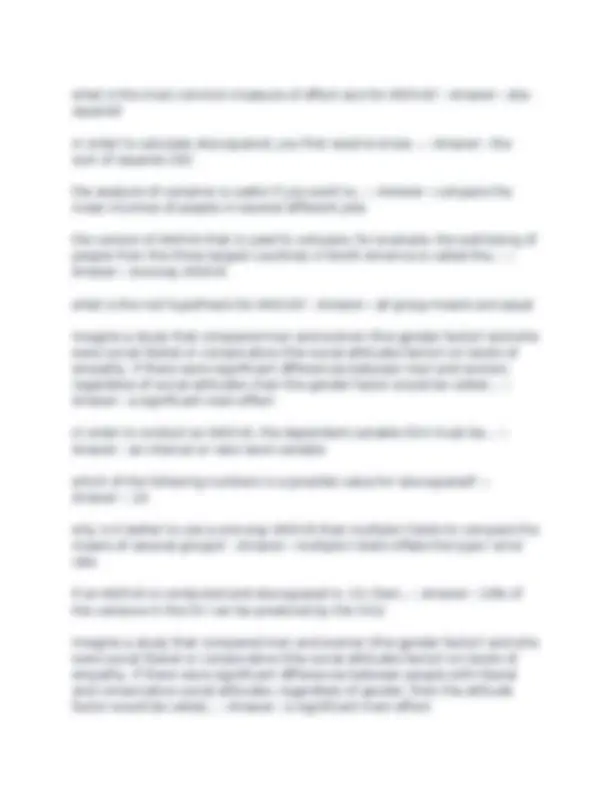
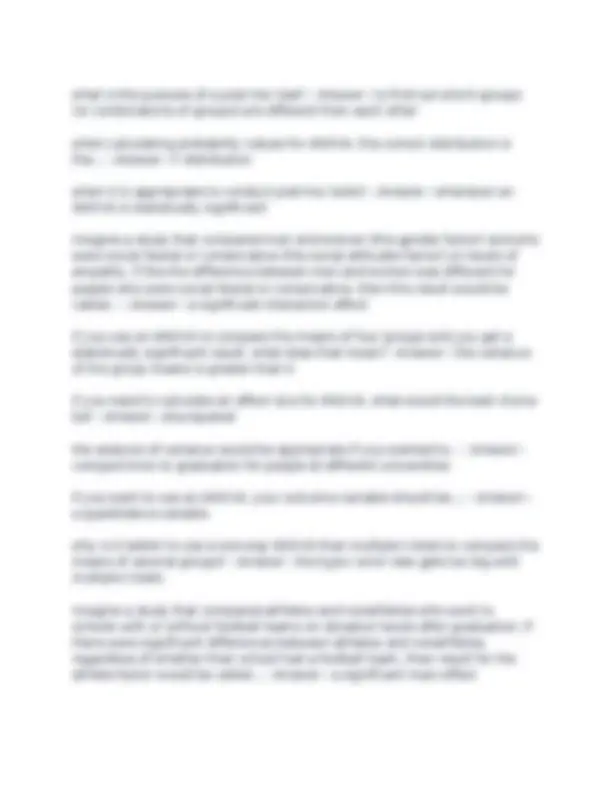
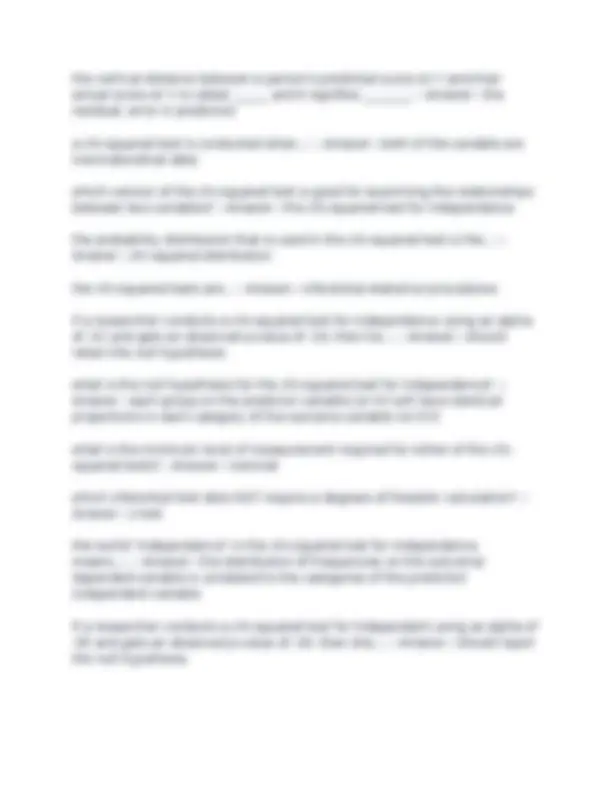
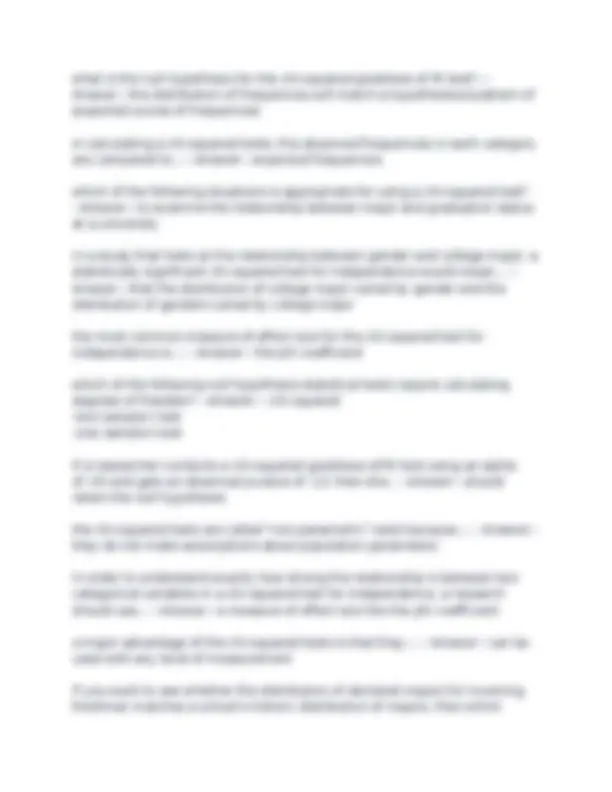
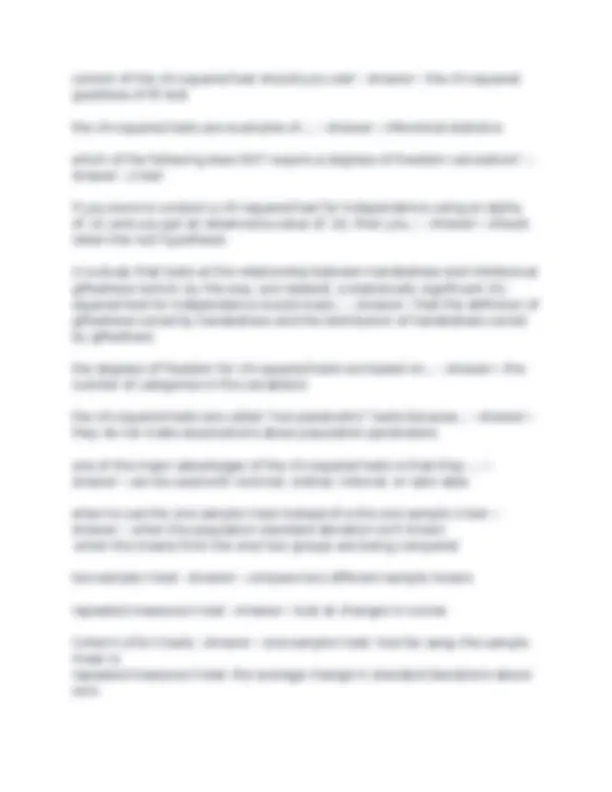
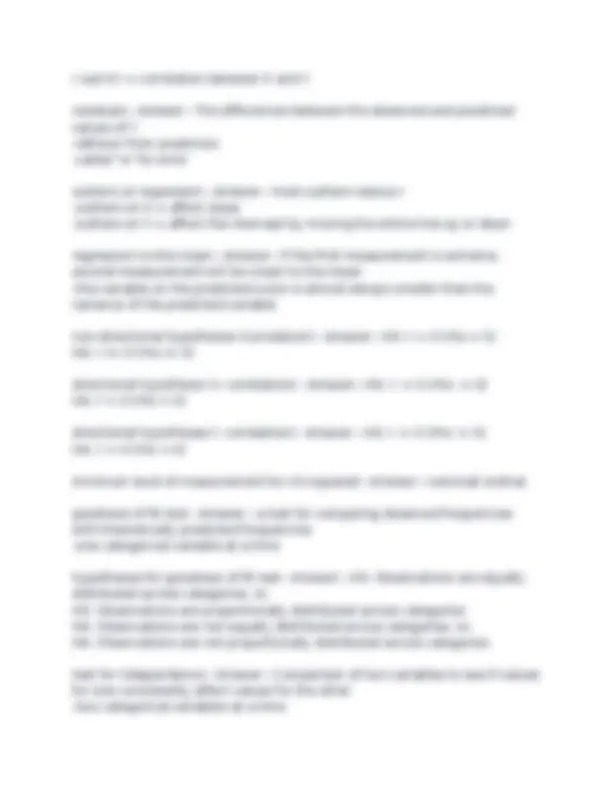



Study with the several resources on Docsity

Earn points by helping other students or get them with a premium plan


Prepare for your exams
Study with the several resources on Docsity

Earn points to download
Earn points by helping other students or get them with a premium plan
Community
Ask the community for help and clear up your study doubts
Discover the best universities in your country according to Docsity users
Free resources
Download our free guides on studying techniques, anxiety management strategies, and thesis advice from Docsity tutors
The two-sample t-test, which is a statistical test used to compare the means of two independent samples. It covers key concepts such as the formula for degrees of freedom, the interpretation of cohen's d, the assumptions of the test, and the interpretation of the test results. The document also compares the two-sample t-test to other statistical tests like anova and discusses the importance of effect size measures. Overall, this document provides a comprehensive overview of the two-sample t-test and its applications in research.
Typology: Exams
1 / 14

This page cannot be seen from the preview
Don't miss anything!









What inferential test should be used to compare two sample means to each other? --Answer-- the two-sample t-test The most important difference between Cohen's d and the t-test is that Cohen's d... --Answer-- is not affected by sample size What is the formula for the degrees of freedom (df) for a two-sample t-test? --Answer-- n- if a researcher wants to compare the effects of an antidepressant to the effects of a placebo on levels of anxiety, then what is the independent variable (that is, the IV)? --Answer-- medication: antidepressant vs. placebo when the means of two groups are the same, then Cohen's d.... --Answer-- will equal 0 a two-sample t-test is an appropriate test when... --Answer-- two samples are being compared on an interval or ratio level variable imagine that a researcher conducts a one-tailed (i.e., directional) two-sample t-test with a critical value of -1.83 and gets an observed value (or test value) of t = +1.98. What is the proper conclusion in this case? --Answer-- retain the null hypothesis Cohen's d indicates the number of... --Answer-- standard deviations between two means if a researcher wants to compare the effects of an antidepressant to the effects of a placebo on levels of anxiety, then what is the dependent variable (that is, the DV)? --Answer-- levels of anxiety
if a researcher gathers data from participates before and after they participate in an exercise training program and wants to know whether their performance scores improved, then he should use.... --Answer-- a one-tailed, repeated measures t-test If a research conducts an inferential test (such as a t-test) and retains (i.e., fails to reject) the null hypothesis, then what is the probability of a Type I error? --Answer-- 0. one assumption of the two-sample t-test is that.... --Answer-- the two samples are independent of one another imagine that a researcher conducts a two-sample t-test with critical values of +-2.10 and gets an observed value (or test value) of t = 1.98. What is the proper conclusion in this case? --Answer-- retain the null hypothesis if a researcher wants to compare the effects of an antidepressant to the effects of a placebo on levels of anxiety, then what is the grouping variable? --Answer-- medication: antidepressant vs. placebo the comparison group in a repeated measures t-test is... --Answer-- each person's own score at time 1 imagine that a researcher conducts a repeated measures t-test with critical values of +-2.78 and gets an observed value (or test value) of t = -3.30. What is the proper conclusion in this case? --Answer-- reject the null hypothesis when the means of two samples are being compared and Cohen's d = 0, then... --Answer-- the means are identical if a researcher conducts an inferential test (such as a t-test) and rejects the null hypothesis, then what is the probability of a type II error? --Answer-- 0. if n = infinity, then what is the critical value of t for alpha = .05? --Answer-- +-1. if a researcher conducts a t-test with an alpha of .01 and gets a p-value of .25, then the researcher should... --Answer-- retain the null hypothesis
what is the most common measure of effect size for ANOVA? --Answer-- eta- squared in order to calculate eta-squared, you first need to know... --Answer-- the sum of squares (SS) the analysis of variance is useful if you want to... --Answer-- compare the mean incomes of people in several different jobs the version of ANOVA that is used to compare, for example, the well-being of people from the three largest countries in North America is called the... -- Answer-- one-way ANOVA what is the null hypothesis for ANOVA? --Answer-- all group means are equal Imagine a study that compared men and women (the gender factor) and who were social liberal or conservative (the social attitudes factor) on levels of empathy. If there were significant differences between men and women, regardless of social attitudes, then the gender factor would be called... -- Answer-- a significant main effect in order to conduct an ANOVA, the dependent variable (DV) must be... -- Answer-- an interval or ratio level variable which of the following numbers is a possible value for eta-squared? -- Answer--. why is it better to use a one-way ANOVA than multiple t-tests to compare the means of several groups? --Answer-- multiple t-tests inflate the type I error rate if an ANOVA is conducted and eta-squared is .10, then... --Answer-- 10% of the variance in the DV can be predicted by the IV(s) Imagine a study that compared men and women (the gender factor) and who were social liberal or conservative (the social attitudes factor) on levels of empathy. If there were significant differences between people with liberal and conservative social attitudes, regardless of gender, then the attitude factor would be called... --Answer-- a significant main effect
what is the purpose of a post-hoc test? --Answer-- to find out which groups (or combinations of groups) are different from each other when calculating probability values for ANOVA, the correct distribution is the... --Answer-- F distribution when it is appropriate to conduct post-hoc tests? --Answer-- whenever an ANOVA is statistically significant Imagine a study that compared men and women (the gender factor) and who were social liberal or conservative (the social attitudes factor) on levels of empathy. If the the difference between men and women was different for people who were social liberal or conservative, then this result would be called... --Answer-- a significant interaction effect if you use an ANOVA to compare the means of four groups and you get a statistically significant result, what does that mean? --Answer-- the variance of the group means is greater than 0 if you need to calculate an effect size for ANOVA, what would the best choice be? --Answer-- eta-squared the analysis of variance would be appropriate if you wanted to... --Answer-- compare time to graduation for people at different universities if you want to use an ANOVA, your outcome variable should be.... --Answer-- a quantitative variable why is it better to use a one-way ANOVA than multiple t-tests to compare the means of several groups? --Answer-- the type I error rate gets too big with multiple t-tests Imagine a study that compared athletes and nonathletes who went to schools with or without football teams on donation levels after graduation. If there were significant differences between athletes and nonathletes, regardless of whether their school had a football team, then result for the athlete factor would be called... --Answer-- a significant main effect
if a person has a middling score on X but a very high score on Y, what would their effect on the regression equation be? --Answer-- they would raise the intercept but not change the slope which of the following illustrates a negative correlation? --Answer-- the more often a person visits the dentist, the fewer cavities they have if r = .65, then the members in a sample who have _____ values on the independent variable have ____ values on the dependent value --Answer-- lower, lower the vertical distance between a person's predicted score on Y and their actual score on Y is called ____ and it signifies _____. --Answer-- the residual; error in prediction which statistic is defined as the proportion of variance accounted in the dependent variable by the independent variable? --Answer-- r-squared If the dots on a scatterplot generally extend from the top left to the bottom right of the diagram but are very widely spread out, the researcher would report the correlation as... --Answer-- negative and weak what is the minimum level of measurement to calculate Pearson's r correlation coefficient? --Answer-- interval when a regression equation doesn't predict a person's score perfectly, then the difference between their predicted score and their actual score is the..... --Answer-- residual If a regression equation is calculated for a sample of data and then a person who is an outlier on both X and Y is added, what would likely happen to the regression equation? --Answer-- the new score would likely change both the intercept and the slope If r = -.4, then the people who have _____ values on the predictor variable generally have _____ values on the outcome variable. --Answer-- lower, higher
the vertical distance between a person's predicted score on Y and their actual score on Y is called ______ and it signifies ________. --Answer-- the residual; error in prediction a chi-squared test is conducted when.... --Answer-- both of the variable are nominal/ordinal data which version of the chi-squared test is good for examining the relationships between two variables? --Answer-- the chi-squared test for independence the probability distribution that is used in the chi-squared test is the... -- Answer-- chi-squared distribution the chi-squared tests are... --Answer-- inferential statistics/ procedures if a researcher conducts a chi-squared test for independence using an alpha of .01 and gets an observed p-value of .04, then he.... --Answer-- should retain the null hypothesis what is the null hypothesis for the chi-squared test for independence? -- Answer-- each group on the predictor variable (or IV) will have identical proportions in each category of the outcome variable (or DV) what is the minimum level of measurement required for either of the chi- squared tests? --Answer-- nominal which inferential test does NOT require a degrees of freedom calculation? -- Answer-- z-test the world "independence" in the chi-squared test for independence means..... --Answer-- the distribution of frequencies on the outcome/ depended variable is unrelated to the categories of the predictor/ independent variable if a researcher conducts a chi-squared test for independent using an alpha of .05 and gets an observed p-value of .04, then she.... --Answer-- should reject the null hypothesis
version of the chi-squared test should you use? --Answer-- the chi-squared goodness of fit test the chi-squared tests are examples of.... --Answer-- inferential statistics which of the following does NOT require a degrees of freedom calculation? -- Answer-- z-test If you were to conduct a chi-squared test for independence using an alpha of .01 and you got an observed p-value of .02, then you... --Answer-- should retain the null hypothesis In a study that looks at the relationship between handedness and intellectual giftedness (which, by the way, are related), a statistically significant chi- squared test for Independence would mean... --Answer-- that the definition of giftedness varied by handedness and the distribution of handedness varied by giftedness the degrees of freedom for chi-squared tests are based on... --Answer-- the number of categories in the variable(s) the chi-squared tests are called "non-parametric" tests because... --Answer-- they do not make assumptions about population parameters one of the major advantages of the chi-squared tests is that they.... -- Answer-- can be used with nominal, ordinal, interval, or ratio data when to use the one sample t-test instead of a the one sample z-test -- Answer-- -when the population standard deviation isn't known -when the means from the one/ two groups are being compared two-sample t-test --Answer-- compare two different sample means repeated measures t-test --Answer-- look at changes in scores Cohen's d for t-tests --Answer-- one-sample t-test: how far away the sample mean is repeated measures t-test: the average change in standard deviations above zero
two-sample t-test: pooled standard deviations, how many standard deviations they are apart from each other independent/ dependent variable t-tests --Answer-- IV: grouping/ manipulated variable DV: outcome variable Type I Errors t-test --Answer-- if you retain the null hypothesis there is a zero percent chance of a type I error Type II Errors t-test --Answer-- if you reject the null hypothesis there is a zero percent chance of a type II error ANOVA level of measurement --Answer-- interval/ ratio independent: qualitative dependent: interval/ ratio when to use ANOVA instead of a t-test --Answer-- -can do more than two groups -more than one predicator variable -more than one outcome variable one-way ANOVA --Answer-- -one factor -compares means of two+ groups at once two-way ANOVA --Answer-- -two factors -use more than one predictor F distribution --Answer-- The distribution that models the ratio of two variance estimates; used in ANOVA for obtaining the P-value for testing equality of three or more means -only has positive values -two degree of freedom calculations Eta squared (n^2) --Answer-- an effect size that calculates the percentage of variability in the dependent variable accounted for by the independent variable -based on sum of squares = SS effect / SS effect + SS error
r sub XY = correlation between X and Y residuals --Answer-- The differences between the observed and predicted values of Y -leftover from prediction -called "e" for error outliers on regression --Answer-- most outliers reduce r -outliers on X = affect slope -outliers on Y = affect the intercept by moving the entire line up or down regression to the mean --Answer-- If the first measurement is extreme, second measurement will be closer to the mean -the variable on the predicted score is almost always smaller than the variance of the predicted variable non-directional hypotheses (correlation) --Answer-- H0: r = 0 (rho = 0) HA: r /= 0 (rho /= 0) directional hypothesis (+ correlation) --Answer-- H0: r -< 0 (rho -< 0) HA: r > 0 (rho > 0) directional hypotheses (- correlation) --Answer-- H0: r -> 0 (rho -> 0) HA: r < 0 (rho < 0) minimum level of measurement for chi-squared --Answer-- nominal/ ordinal goodness of fit test --Answer-- a test for comparing observed frequencies with theoretically predicted frequencies -one categorical variable at a time hypotheses for goodness of fit test --Answer-- H0: Observations are equally distributed across categories, or, H0: Observations are proportionally distributed across categories HA: Observations are not equally distributed across categories, or, HA: Observations are not proportionally distributed across categories test for independence --Answer-- Comparison of two variables to see if values for one consistently affect values for the other -two categorical variables at a time
hypotheses for the test for independence --Answer-- H0: The distribution of observations is independent for the two variables HA: The distribution of observations is not independent for the two variables